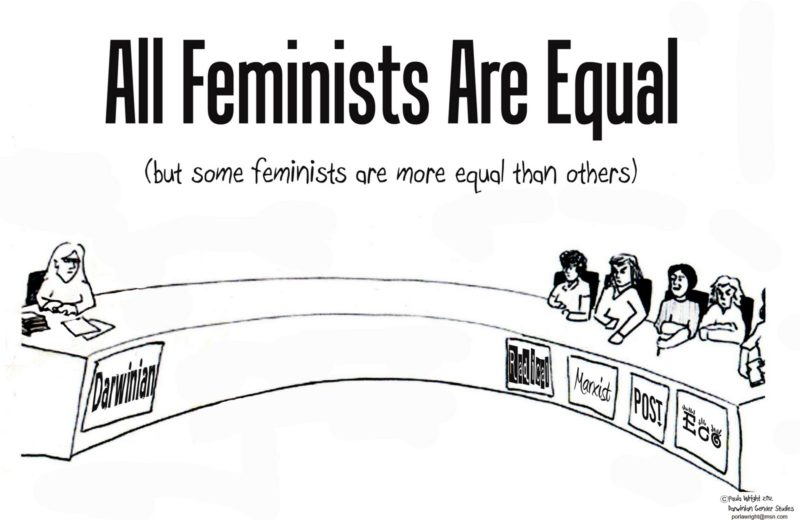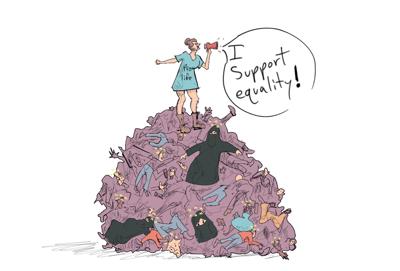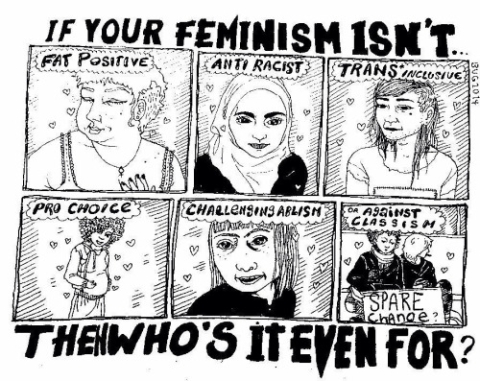
21 Mar A FEMINIST’S OPPOSITION OF FEMINISM
by HANAN IRFAN
Can you desire feminism for yourself and not for others? Can you advocate for intersectionality while rejecting certain feminist discourses? Can you claim to be a feminist while rejecting feminism? I, as a feminist, do.
In my experience as a Muslim woman who claims to be a feminist, I have often encountered women of my own community not just being hesitant about accepting “feminism” but often being vehemently opposed to it. At first, I am guilty of accusing them of internalizing misogyny, being the “enabling patriarchy” and other similar feminist lingos that I learnt during my study of gender and related issues. Funnily enough, a term that escaped my eyes till very recently, something that made me reassess my stance and lend some slack to women of lesser privilege than I was something that basically defines the role of feminism for the majority of feminists around the subaltern world: Embedded Feminism.

The foundation of resentment among Muslim towards Feminism is the inherent “westernization” of the concept. I have heard various versions from women who actually believed they belonged behind the four walls to women who were earning more than males in their family, all rejecting feminism. Should the opposition to something foreign, a perceived nemesis be to such an extent that it debilitates your own position in society, I wondered. The funniest thing being, these women describing all the “ideas” of empowerment singularly they aspired to achieved or had achieved but refused to call it “feminism”. Is it just blind paranoia towards alien concepts and the dominant culture? Further prodding has opened an entirely new horizon of feminism meant for me and my likes that had been cleverly hidden, appropriated and vilified.
HISTORY/ SEQUENCE OF EVENTS
“The fights against terrorism are also a fight for the rights and dignity of women”,
touted The First Lady Laura Bush in the presidential address to the nation on 17th November 2001. What followed was a brutal military invasion of a nation and unprecedented butchering and carpet-bombing thousands of civilians with the intention of liberating the “women in cover”.
Embedded Feminism as coined by Krista Hunt refers to the co-option of feminist discourses in order to legitimize military intervention of the government or gentrification of marginalized spaces. In its best form, it is nothing but a propaganda technique aimed at the vilification of the subaltern by the hegemonic culture. At its worst, it is a legitimizing factor for genocide and imperialism.
Soon after the bombings of 9/11, the White House began to show unprecedented interest and unconditional solidarity with the Afghan women or “sisters in cover” as Bush liked to call. The presidential addresses began to be inundated with feminist rhetoric indicating a firm resolve to liberate the “veiled women” from the same Taliban that the US had acquiesced to till very recently. The magazines and the newspapers were loaded with images of obscure women in burqa and political statements were dotted with feminist quotations by mainstream feminist groups like the FMRF (Feminist Majority Front).

Similarly, in 2004, the US government after having stood by Saddam Hussain at the peak of his atrocities suddenly decided to champion the cause of Iraqi Women. The intention was validated by a few privileged “Women for Free Iraq” with the support of mainstream American feminist groups. The systematic political annihilation, breakdown of infrastructure and society was a sight to watch as western feminists cheered hoping to liberate women by reducing a nation already grappling with poverty, malnutrition, lack of education and terrorism to debris.
Initially advocating support to the US, it did not take long for Afghan and Iraqi feminists to realize you cannot bomb your way to a feminist revolution.
HONEST MISTAKE OR SAVIOUR COMPLEX?
The support of western feminist groups to their governments may be said to be coming from a good place in its intentions being positive and “charitable”. But to say so is to immensely downplay the class inequalities, cultural hegemony and pervading imperialistic ambitions of the dominant power that have been highlighted by the third feminist wave. The feminist movement isn’t in a vacuum outside class and racial inequalities. One of the greatest follies of the first wave of white supremacist feminism being recreated even now is to assume women to be a homogeneous entity whereby they share the same experiences by virtue of their gender. The virtual sisterhood or misplaced sense of solidarity often is appropriation, misrepresentation, and encroachment of spaces meant for the “other”, here, the subaltern.

As the burqa soon became the symbol of oppression of Muslim which the western feminists were determined to abolish. Amidst this misrepresentation of middle eastern feminism, the pivotal and primary demands of these very women were ignored. Their voices were subdued by the lamentations of white feminists. Political and cultural reasons responsible for repression of feminist voices were twisted by the western media to give a primary religious overtone for their own political gamblings. As Krista Hunt puts it,
“Indeed the western media’s obsession with the burqa chose to exclude its utilization by Afghan feminists to smuggle schoolbooks and cameras to women’s groups.”
In fact, many activists spoke of the burqa allowing them the freedom to continue their work…Billaud writes that, for many women, the chadari increased their mobility while guaranteeing their anonymity, a precious asset in a volatile security environment. However western feminists and the western media tended to dismiss the idea that such appropriation of this garment could be in any way empowering or normalized.”

Under these scenarios, Muslim women trying to bring attention to burning issues of security, sexual violence, education, malnutrition, poverty were conveniently ignored. Burqa, religion, and prohibition of nail paints became the objective definitions and pillars of oppression, the only ones that needed to be addressed. It was unanimously accepted by white feminists, as Gayatri Spivak puts it,
“White men needed to save brown women from brown men”.
How could the white men responsible for the oppression of white feminists empower brown women? The answer lies in the internalized and accepted cultural and moral superiority of the colonizers.
THE PREVAILING IMPRINT OF FEMINISM
A pivotal observation of the first wave of feminists, the suffragists and the reason for the disdain towards the same is being an organ of white supremacy. The earliest feminists were blatant racists, slaveholding and white supremacists.

The apparent feminizing revolution in the middle east led to a genocide of thousands, the annihilation of the entire nation and ultimately promoting hyper patriarchy, further deteriorating the position of women. The wrapper of feminism was used to sell the infamous War on Terror which was further legitimized and validated by western feminist circles. The problem with the misrepresentation and speaking over voices and ignoring cultural, racial-ethnic influences in the experiences of feminism is that the grassroots issues were ignored and the movement was reduced to symbolism with the main fight being waged against the identity of Afghan and Iraq women. This was ultimately used to spread paranoia in the society, as a cultural annexation by the west, or civil degradation.

The Taliban hadn’t invented the burqa nor the burqa was the primary concern of middle eastern feminists. The subjectivity in choosing to wear a modest garb was replaced by the objectivity of abandoning the symbol of oppression irrespective of the choice. This was in turn viewed by the Muslim women as an attack on their identity and free will, not just in the middle east but globally. Similar sentiments were fanned by religious fundamentalists who retaliated by forcing the hijab and burqa even more ardently. Amidst this tug of war of forced covering and forced uncovering, both in the name of protection, liberation, and empowerment, the essence of individual freedom of choice was long forgotten. Western feminism turned out to be no different than the preceding extreme politico-religious shackles imposed upon them. Despite claiming to be radically opposed to each other, either denied the right to self-determination to women.

As the crackdown on subaltern Muslim societies continues, it is only understandable that Muslim women cannot recollect any visions of feminism without the destruction it accompanies. Colonial feminism has become the hallmark of intervention and destruction. Not only were the physical aspects of destruction appalling but the intellectual and emotional degradation women was systematically achieved. Anyone opposing this supremacist imperialistic version of savior feminism was deemed brainwashed or having “internalized misogyny” hence invalidating all opposition. Eventually, embedded feminism has given rise to a climate of resentment in Muslim societies globally and is seen as a mode to promote western cultural supremacy without having the interests of the target groups at heart.
It is seen as a means of cultural imperialism and further alienation of rights, choice, and identity than already existing. Western feminism for these women is not an ally but instead, another nemesis imposed shackles, set of dictated terms to be fought. Another catch being, it was not presented as “western feminism” or “colonial feminism”; it was simply “Feminism”.
TRIPLE TALAQ BILL: A MANIFESTATION OF EMBEDDED FEMINISM

The overarching principle of Intersectional Feminism is that the experiences of women are defined by an overlapping structure of class, race, ethnicity, culture, geopolitics to name a few. As wide as the gulf might be in the experiences of white women and women of colour, the differences don’t end there. The extensive social stratification within one community gives rise to a substructure imitating the global hierarchical superstructure. Similar imprints of cultural hegemony, subaltern narratives, embedded narratives, a feminist, in this case, saviour sentimentality can be found within a community as well.

Embedded Feminism isn’t restricted for the legitimization of militarisation but simply weaponizing feminism to further the state’s agenda. In this light, it certainly won’t be folly to observe the Triple Talaq Bill proposed in the Indian parliament as a not so subtle manifestation of the same. The narrative of saving “Brown women from brown men” is changed into “saving Muslim women from Muslim men” yet again.
It is no secret how the issue of triple talaq has been given momentum to grind political stones and polarise votes. It has been conflated as an instrument of empowerment for Indian Muslim women, and apparently the most urgent one. A crisis. The reality-based on governmental data lies far from the hype created. According to surveys conducted by CRDDP (Centre for Research and Debates in Development Policy) based in Delhi Triple Talaq is almost a non-existing problem accounting for only 0.3% of the divorce cases. Despite the Supreme Court declaring the practice as “non Est”, invalid, unholding, the government pushes for a particularly troubling bill with unprecedented urgency. The urgency that is nowhere to be seen for around 50% illiterate Muslim women, for the lowest high school enrolment rates of any community in the country, for being the only community to show downward mobilization in intergenerational mobility index and many more. The Indian Muslim community wholeheartedly accepted the SC verdict of invalidating Triple Talaq, then why introduce a bill whose sole purpose is to “criminalise” Muslim men for something that isn’t even legally recognized anymore? The controversial bill seeks to imprison Muslim men for pronouncing tripe talaq for upto three years along with a hefty fine which resulted in an uproar in the community.

Why does the government seek to imprison men from a community that already have an unproportionable representation in prison and undertrials with respect to their population for something that is already “invalid” as per the highest court of the country. The sudden traction given to this issue of Triple Talaq in the name of empowering Muslim women has served only to vilify Muslim men, and dare I say it, seeks to erode the social fabric of Muslim households putting them at the mercy of a biased law and false accusations.
For among 2.37 million women categorized as “separated” in the country, 1.9 million are Hindu and 0.28 million are Muslims. The Muslim community realizes the intervention being planned in social structures and private affairs under the garb of charity and saviour sentiments and has been vociferous in their reproach for which they have been accused of misogyny. There is no denial of patriarchy in any community, Muslims being no exception, but the cunning manipulation of feminist rhetoric and blowing irrelevant problems out of proportions in order to achieve political gains and votes polarisation is something that cannot be ignored.

The community is stuck between the choice of barricading their social structures and downplaying a minor yet existing evil and that of acquiescing to foreign interference to save face knowing it will yield no results and is only a political gimmick. The resentment to intervention and infiltration is projected by the dominant power as resentment to progressive feminist ideals. Hence in a war waged by the hegemonic power, it is the feminists and subaltern pitted against one another thereby harming the interests of both.
Under the given scenarios, the subaltern is under no obligation to support an ideal that is associated with wreaking havoc and carefully manipulated to vilify them. Feminism in its supremacist form, non-intersectional form, embedded form, has been a pretty old political weapon to subjugate communities culturally. To enforce such communities to simply “forget and forgive” systemic physical, cultural, intellectual, moral denigration is nothing but a disregard of trauma and manifestation of supremacist mindset. The belief that your way is the only way and any deviations are uncouth, uncivilised, regressive is a clear imitation of colonialist tendencies.
Maybe they haven’t “internalised misogyny, maybe mainstream feminists have internalised supremacist feminism.

Intersectionality requires validation of experiences of women beyond simply the gender lens. Intersectionality requires feminists to be allies to other feminists who have varied experiences and allow them to lead their own battles. The make-believe universal sorority shouldn’t threaten alienation to subaltern narratives for being inconsistent with the popular feminist discourses.
